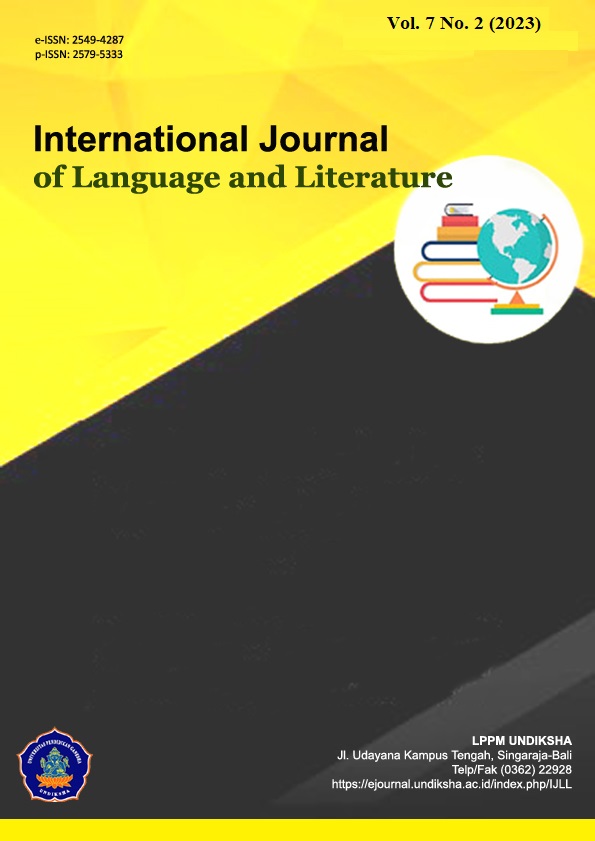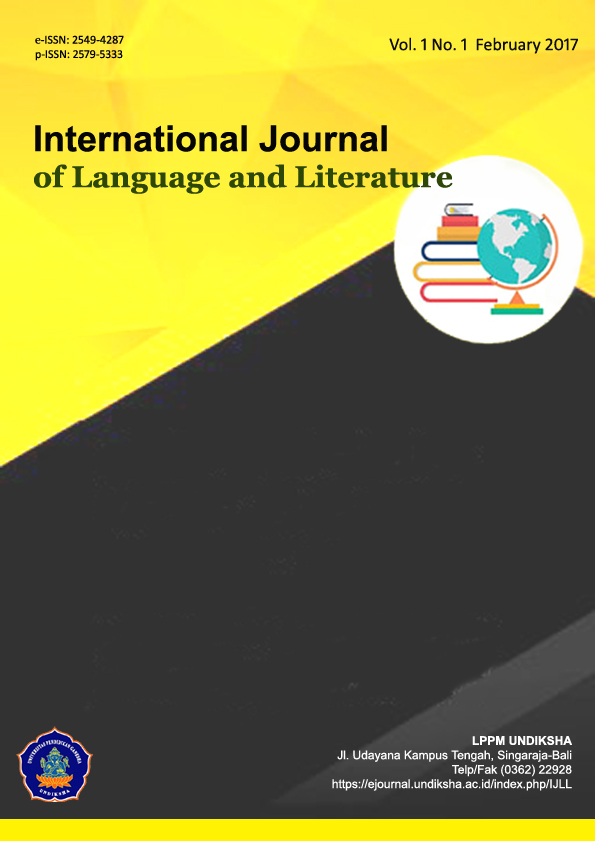Perceived Teaching Creativity and Strategy of Implementation in Distance Learning Activities
DOI:
https://doi.org/10.23887/ijll.v7i2.31771Keywords:
Creativity, Teachers’ Creativity, 21st Century Learning, Distance LearningAbstract
Distance learning has been implemented in many schools due to covid-19. But it is still unknown whether teachers integrate creativity in learning still needs to be investigated. Therefore the aims of this study are to analyze how the teachers perceived their own creativity in teaching in the classroom. Then how they implanted in distance learning and analyze there is the discrepancy occurred between how the teachers’ perception toward their creativity and the facts of how the teachers implemented their creativity in the real teaching. Mix method was employed as the design of this study which meant there were primary and supportive data. The qualitative data was dominant than quantitative data. The setting of this study was in senior high school and two English teachers selected as the subject of this study. Self-rated questionnaire and classroom observation sheet were used as the instruments. The result of study showed that the teachers perceived themselves as creative, however, the teachers’ creativity was classified in slightly creative based on the observation. Those data demonstrated that there was the discrepancy between the teachers’ perception toward their creativity in the class. The implication of this research is the creativity in distance learning requires more than teachers' willingness, it also requires students' financial support.
References
Andrian, Y., & Rusman, R. (2019). Implementasi pembelajaran abad 21 dalam kurikulum 2013. Jurnal Penelitian Ilmu Pendidikan, 12(1). https://doi.org/10.21831/jpipfip.v12i1.20116. DOI: https://doi.org/10.21831/jpipfip.v12i1.20116
Astuti, A. P., Aziz, A., Sumarti, S. S., & Bharati, D. A. L. (2019). Preparing 21st Century Teachers: Implementation of 4C Character’s Pre-Service Teacher through Teaching Practice. Journal of Physics: Conference Series, 1233(1). https://doi.org/10.1088/1742-6596/1233/1/012109. DOI: https://doi.org/10.1088/1742-6596/1233/1/012109
Boholano, H. (2017). Smart social networking: 21st Century teaching and learning skills. Research in Pedagogy, 7(2), 21–29. https://doi.org/10.17810/2015.45. DOI: https://doi.org/10.17810/2015.45
Boyadzhieva, E. (2016). Learner-centered Teaching and Learner Autonomy. Procedia - Social and Behavioral Sciences, 232, 35–40. https://doi.org/10.1016/j.sbspro.2016.10.008. DOI: https://doi.org/10.1016/j.sbspro.2016.10.008
Creswell, J. H., & Creswell, J. D. (2018). Research Design: Qualitative, Quantitative, and Mixed Methods Approaches (Fifth Edition). Thousand Oaks, CA: SAGE.
Diah Rusmala Dewi. (2019). Pengembangan Kurikulum Di Indonesia Dalam Menghadapi Tuntutan Abad Ke-21. As-Salam: Jurnal Studi Hukum Islam & Pendidikan, 8(1), 1–22. https://doi.org/10.51226/assalam.v8i1.123. DOI: https://doi.org/10.51226/assalam.v8i1.123
Erdoğan, V. (2019). Integrating 4C Skills of 21st Century into 4 Language Skills in EFL Classes. International Journal of Education and Research, 7(11), 113–124. https://www.ijern.com/journal/2019/November-2019/09.pdf.
Fatimah, A. S., & Santiana, S. (2017). Teaching in 21St Century: Students-Teachers’ Perceptions of Technology Use in the Classroom. Script Journal: Journal of Linguistic and English Teaching, 2(2), 125. https://doi.org/10.24903/sj.v2i2.132. DOI: https://doi.org/10.24903/sj.v2i2.132
Ferrer, E., & Staley, K. (2016). Designing an EFL Reading Program to Promote Literacy Skills, Critical Thinking, and Creativity. CATESOL Journal, 28(2), 79–104. https://eric.ed.gov/?id=EJ1119613.
Fitriyani, Y., Fauzi, I., & Sari, M. Z. (2020). Motivasi Belajar Mahasiswa Pada Pembelajaran Daring Selama Pandemik Covid-19. Profesi Pendidikan Dasar, 7(1), 121–132. https://doi.org/10.23917/ppd.v7i1.10973. DOI: https://doi.org/10.23917/ppd.v7i1.10973
Haryadi, R., & Selviani, F. (2021). Problematika Pembelajaran Daring Di Masa Pandemi Covid-19. Academy of Education Journal, 12(2), 254–261. https://doi.org/10.47200/aoej.v12i2.447. DOI: https://doi.org/10.47200/aoej.v12i2.447
Herliandry, L. D., Nurhasanah, N., Suban, M. E., & Kuswanto, H. (2020). Pembelajaran Pada Masa Pandemi Covid-19. JTP - Jurnal Teknologi Pendidikan, 22(1), 65–70. https://doi.org/10.21009/jtp.v22i1.15286. DOI: https://doi.org/10.21009/jtp.v22i1.15286
Hidayatullah, Z., Wilujeng, I., Nurhasanah, N., Gusemanto, T. G., & Makhrus, M. (2021). Synthesis of the 21st Century Skills (4C) Based Physics Education Research In Indonesia. JIPF (Jurnal Ilmu Pendidikan Fisika), 6(1), 88. https://doi.org/10.26737/jipf.v6i1.1889. DOI: https://doi.org/10.26737/jipf.v6i1.1889
Hossain, A., & Rezal, M. (2018). Integration of Structured Cooperative Learning in Mathematics Classrooms. International Journal of Psychology and Educational Studies, 5(1), 23–29. https://doi.org/10.17220/ijpes.2018.01.004. DOI: https://doi.org/10.17220/ijpes.2018.01.004
Jacobs, G. M., & Toh-heng, H. L. (2013). Proceedings of the International Conference on Managing the Asian Century. Proceedings of the International Conference on Managing the Asian Century, 55–64. https://doi.org/10.1007/978-981-4560-61-0. DOI: https://doi.org/10.1007/978-981-4560-61-0_7
Kumar, A., Krishnamurthi, R., Bhatia, S., Kaushik, K., Ahuja, N. J., Nayyar, A., & Masud, M. (2021). Blended Learning Tools and Practices: A Comprehensive Analysis. IEEE Access, 9. https://doi.org/10.1109/ACCESS.2021.3085844. DOI: https://doi.org/10.1109/ACCESS.2021.3085844
Kurniawati, N., Maolida, E. H., & Anjaniputra, A. G. (2018). The praxis of digital literacy in the EFL classroom: Digital-immigrant vs digital-native teacher. Indonesian Journal of Applied Linguistics, 8(1), 28–37. https://doi.org/10.17509/ijal.v8i1.11459. DOI: https://doi.org/10.17509/ijal.v8i1.11459
Lase, D., Zaluchu, S. E., Daeli, D. O., & Ndraha, A. (2022). Parents’ Perceptions of Distance Learning during Covid-19 Pandemic in Rural Indonesia. Journal of Education and Learning (EduLearn), 16(1), 103–113. https://doi.org/10.11591/edulearn.v16i1.20122. DOI: https://doi.org/10.11591/edulearn.v16i1.20122
Lewin, C., & Mcnicol, S. (2015). Supporting the development of 21st century skills through ICT. KEYCIT 2014: Key Competencies in Informatics and ICT, 181–198.
Limpraptono, F. Y., & Nurcahyo, E. (2021). The Development of Electronics Telecommunication Remote Laboratory Architecture Based on Mobile Devices. International Journal of Online and Biomedical Engineering, 17(3), 26–36. https://doi.org/10.3991/ijoe.v17i03.20179. DOI: https://doi.org/10.3991/ijoe.v17i03.20179
Magdalena, I., Maula, N. H., Amelia, S. A., & Ismawati, A. (2020). Evaluasi Penerapan Pembelajaran K13 di Sekolah Dasar Dharmawati Arief Tangerang. MANAZHIM, 2(1). https://doi.org/10.36088/manazhim.v2i1.596. DOI: https://doi.org/10.36088/manazhim.v2i1.596
Mithen, Onesimus, Arfandi, A., Raeny, & Rahmansah. (2021). Science teachers abilities in integrating population and environmental education with science subjects of junior high school in Mamasa regency, Indonesia. Jurnal Pendidikan IPA Indonesia, 10(1), 81–91. https://doi.org/10.15294/jpii.v10i1.27012. DOI: https://doi.org/10.15294/jpii.v10i1.27012
Muhali, M. (2019). Pembelajaran Inovatif Abad Ke-21. Jurnal Penelitian Dan Pengkajian Ilmu Pendidikan: E-Saintika, 3(2), 25–50. https://doi.org/10.36312/e-saintika.v3i2.126. DOI: https://doi.org/10.36312/e-saintika.v3i2.126
Norahmi, M. (2017). 21st-century teachers: The students’ perspectives. Journal on English as a Foreign Language, 7(1), 77. https://doi.org/10.23971/jefl.v7i1.538. DOI: https://doi.org/10.23971/jefl.v7i1.538
Rahmatullah, A. S., Mulyasa, E., Syahrani, S., Pongpalilu, F., & Putri, R. E. (2022). Digital era 4.0. Linguistics and Culture Review, 6, 89–107. https://doi.org/10.21744/lingcure.v6nS3.2064. DOI: https://doi.org/10.21744/lingcure.v6nS3.2064
Rusdin, N. M. (2018). Teachers’ Readiness in Implementing 21st Century Learning. International Journal of Academic Research in Business and Social Sciences, 8(4). https://doi.org/10.6007/ijarbss/v8-i4/4270. DOI: https://doi.org/10.6007/IJARBSS/v8-i4/4270
Saykılı, A. (2018). Distance education: Definitions, generations, key concepts and future directions. International Journal of Contemporary Educational Research, 5(1), 2–17. https://dergipark.org.tr/en/download/article-file/498240.
Selman, Y. F., & Jaedun, A. (2020). Evaluation of The Implementation of 4C Skills in Indonesian Subject at Senior High Schools. Jurnal Pendidikan Indonesia, 9(2), 244–257. https://doi.org/10.23887/jpi-undiksha.v9i2.23459.
Setyoningsih. (2015). E Learning : Pembelajaran Interaktif Berbasis Teknologi. Elementary, 3(1), 39–58. https://doi.org/http://dx.doi.org/10.21043/elementary.v3i1.1443.
Sugiyono. (2018). Metode Penelitian Kombinasi (Mixed Methods). CV Alfabeta.
Suwartono, T., & Aniuranti, A. (2019). Digital Teaching Tools in 21st Century EFL Classroom: Are Our Teachers Ready? ELLITE: Journal of English Language, Literature, and Teaching, 3(2), 57. https://doi.org/10.32528/ellite.v3i2.1916. DOI: https://doi.org/10.32528/ellite.v3i2.1916
Tiarasari, A. T., Sukarno, S., & Sarwanto, S. (2018). Interactive Multimedia Use To Increase Learning Interest. Social, Humanities, and Educational Studies (SHEs): Conference Series, 1(1), 38–47. https://doi.org/10.20961/shes.v1i1.23540. DOI: https://doi.org/10.20961/shes.v1i1.23540
Vastyanov, R., Yermuraki, P., Stoyanov, A., Tiron, O., Beseda, Y., Ostapenko, I., Dobrovolsky, V., Lapshin, D., & Stecenko, A. (2021). New aspects of pedagogical activity in the distant form of pathological physiology teaching to medical university students. Journal of Education, Health and Sport, 11(10), 173–186. https://doi.org/10.12775/jehs.2021.11.10.015. DOI: https://doi.org/10.12775/JEHS.2021.11.10.015
Yalcinalp, S., & Avci, Ü. (2019). Creativity and Emerging Digital Educational Technologies: A Systematic Review. Turkish Online Journal of Educational Technology - TOJET, 18(3), 25–45.
Yefimenko, I. V., Yakymchuk, O. M., Kravtsova, N. Y., Sotska, H. I., & Korol, A. M. (2021). Art education development in the context of global changes. Linguistics and Culture Review, 5(S2). https://doi.org/10.21744/lingcure.v5ns2.1386. DOI: https://doi.org/10.21744/lingcure.v5nS2.1386
Yu, T. X., & Wan Mohammad, W. M. R. (2019). Integration of 21st Century Learning Skills (4C Elements) in Interventions to Improve English Writing Skill Among 3K Class Students. International Journal of Contemporary Education, 2(2), 100. https://doi.org/10.11114/ijce.v2i2.4498. DOI: https://doi.org/10.11114/ijce.v2i2.4498
Yudha, F., Dafik, D., & Yuliati, N. (2018). The Analysis of Creative and Innovative Thinking Skills of the 21st Century Students in Solving the Problems of “Locating Dominating Set” in Research Based Learning. International Journal of Advanced Engineering Research and Science, 5(3), 163–176. https://doi.org/10.22161/ijaers.5.3.21. DOI: https://doi.org/10.22161/ijaers.5.3.21
Downloads
Published
How to Cite
Issue
Section
License
Copyright (c) 2023 International Journal of Language and Literature

This work is licensed under a Creative Commons Attribution-ShareAlike 4.0 International License.
IJLL Journal provides immediate open access to its content on the principle that making research freely available to the public to supports a greater global exchange of knowledge.

This work is licensed under a Creative Commons Attribution-ShareAlike 4.0 International License








